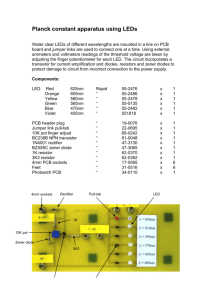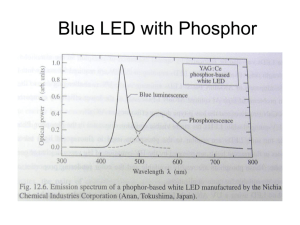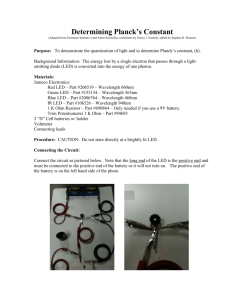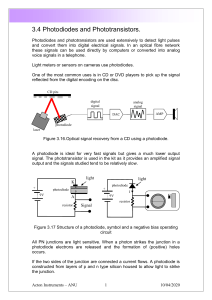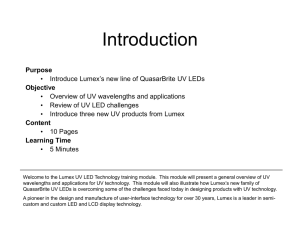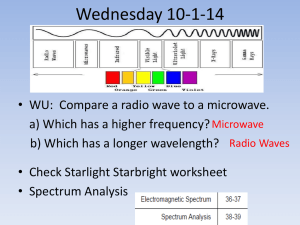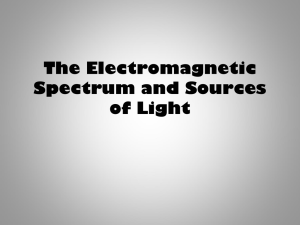2. Study of photodiodes and photo
advertisement
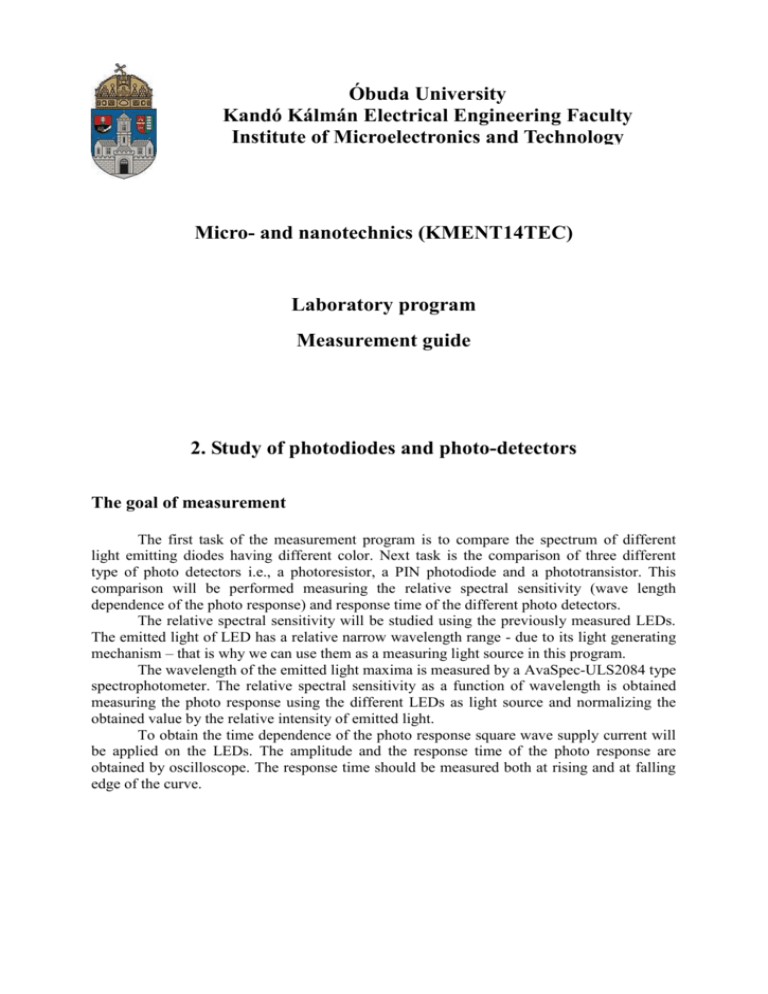
Óbuda University Kandó Kálmán Electrical Engineering Faculty Institute of Microelectronics and Technology Micro- and nanotechnics (KMENT14TEC) Laboratory program Measurement guide 2. Study of photodiodes and photo-detectors The goal of measurement The first task of the measurement program is to compare the spectrum of different light emitting diodes having different color. Next task is the comparison of three different type of photo detectors i.e., a photoresistor, a PIN photodiode and a phototransistor. This comparison will be performed measuring the relative spectral sensitivity (wave length dependence of the photo response) and response time of the different photo detectors. The relative spectral sensitivity will be studied using the previously measured LEDs. The emitted light of LED has a relative narrow wavelength range - due to its light generating mechanism – that is why we can use them as a measuring light source in this program. The wavelength of the emitted light maxima is measured by a AvaSpec-ULS2084 type spectrophotometer. The relative spectral sensitivity as a function of wavelength is obtained measuring the photo response using the different LEDs as light source and normalizing the obtained value by the relative intensity of emitted light. To obtain the time dependence of the photo response square wave supply current will be applied on the LEDs. The amplitude and the response time of the photo response are obtained by oscilloscope. The response time should be measured both at rising and at falling edge of the curve. Measurement setup The light source and the sensor are placed at the ends of the metal tube in the test setuo. The monochromatic light filter could be placed into the slot being in the middle of the tube. Different LEDs are working as the light source. They are 7 with different colors from red to blue, one infrared (IR) and two so-called cold and warm-white, with correlated color temperature 3000K and 5600K, respectively. These LEDs have 1.2 W light power at 400 milliamps, but it is not fully applied in this measurement. All of these LEDs are mounted on numbered PWBs having pins to ensure connection to the current generator. The LEDs are supplied by 26mA current using the current generator (IC: LM338). The current generator supply is 8 Volts DC, which will be fed through the BNC connector. The sensors are: one photodiode, one phototransistor and one photoresistor. They are mounted onto similar PWBs as the light sources. The cable to be connected their pins is mounted to the banana plugs directly to two of them and through a resistor to the others two. The phototransistor is mounted together with an emitter resistor on its PWB. (Fig. 1) 2 The usage of the sensors: In the case of the photoresistor its resistance is to be measured. The easiest way is to use the multi-meter in ohmmeter regime. The resistance of the photoresistor is the highest in the dark (could be as large as mega ohms) and will be much smaller as irradiated. Its response time is rather high, that is why it is applied in those situations where the fast response not a requirement even undesirable, e.g., a nightfall switch. The photodiode is applied in the solar cell mode since the planned measurement does not require high accuracy. The solar cell mode means the 4th quadrant in the I-V plot (Fig. 2.), in this case applying a properly chosen load (e.g., resistance less than 1 kOhm for Fig. 2) the photodiode works as a current generator, its current is proportional to the incident light power. Since the input resistance of a current meter is surely enough small, it can be used to measure the light induced current of the diode. The light absorbed in the base of a phototransistor is generating the base current of it (and the collector current is controlled by this base current according to IC=IB). To measure the current of the phototransistor the resistance located at the banana plugs has to be connected in between the power supply (8V +) and the collector point. Measuring the collector bias to calculate the collector current is straightforward. Fig. 1: a) The phototransistor’s circuit on the PWB; b) connecting it for the measurement Fig. 2: I-V-luminance plot of a photodiode 3 The usage of the spectrometer The spectral distribution of the given light sources could be measured applying the AvaSpec-ULS2084 spectrophotometer. The spectral distribution of the irradiated power in μW/cm2/nm units is obtainable using the I(rradiance) mode in calibrated status. Applying the S(cope) regime the y axes will show only the counts (C) of the detector. This is an uncalibrated regime. The measurement starts with clicking the Start button (upper left). Below the Start button there are the Integration time and the Average switch. Increasing the integration time the unit become more sensitive. It is not necessary to modify during the measurement, only if too small values are detected. The Average function is to filter the noise. Changing the averaging value and restarting the measurement its effect can be seen. The S A T I icons partly mentioned before, they are pushbuttons for the different modes of operation. Right to the I icon is the button of automatic scaling of the y axis. It is advisable to use in the course of the measurement. To the right from it the fifth button is the Cursor switch. Applying the Cursor switch a cursor line will appear which is moveable by the mouse. The position of the cursor – the actual wavelength – is displayed above the graph, while the actual amplitude is given below the graph. Fig. 3: The spectrum of a cold-white LED with the cursor line 4 Fig. 4: The spectrum of a monochrome LED. (The right-side part at infrared is due to the improper calibration). Measurement tasks 1. Spectral investigation of LEDs Using the spectrophotometer AvaSpec-ULS2084 and the program „AvaSoft 7.5 for USB” the spectrum of the LEDs should be measured and documented, the wavelength of the maximum and the width to height ratio should be recorded for each LEDs. The width of the spectrum is defined as the wavelength difference between the two points having half of the maximal intensity. It is easily seen in the case of monochrome LEDs. The wavelength of the maximal intensity will be used to evaluate the relative spectral sensitivity. Since the spectrum of the white LEDs is too wide the above defined task could not be performed for them. Studying their spectrum their working principle could be recalled as the white light is produced by luminescent powder irradiated by blue or UV light LED. The luminescent powder is transforming partly the high energy incident light into a lower energy (i.e. higher wavelength) light radiation. In the case of cold-white LEDs the spectrum contains more blue lines, while the warm-white ones contain more yellow components. The white LEDs could be used to study the monochrome filters located in the black container of the test setup. Let’s insert a filter into its slot and measure the resulted spectrum. Evaluating the width of the resulted spectrum the effect of the filter can be easily demonstrated. 5 2. Relative spectral sensitivity Each photodetector should be measured using the whole set of LEDs. It gives a set of voltage values versus of peak wavelength of the given LED. The relative spectral sensitivity value is equal to the measured voltage divided by a scaling factor. The scaling factor is taking into account the different light intensities of the respective LEDs. The scaling factors are coming from the spectral measurements done using the calibrated, I(rradiance) mode. In this mode the amplitude of the peak values result the scaling factor. 3. Response time measurement The response time of each detector should be measured. To measure the response time at the rising and falling edge of the outgoing signal of the detectors the LEDs current must be a proper frequency square wave and signal should be measured by an oscilloscope. Each detector will be measured with those LED which results the highest sensitivity value. The definition of response time is given in Fig. 5. Fig. 5: Definition of the response time at the rising and falling edge, (e=2.718…) To measure the photoresistor it is connected serially with a resistor and a supply voltage is applied. In this way creating a voltage divider we are able to detect the signal using the oscilloscope. The process is the same for the photodiode and the phototransistor. Equipments to be used Test fixture Triple power supply (Hameg HM8040), ±15V and +5V Impulse generator (TGP110) Digital multimeter (Hameg HM8012) Oscilloscope (Hameg HM303-6 or Hameg HM400) Spectrophotometer (AvaSpec-ULS2084) 6 Review questions Sketch the I-V-luminance characteristics of a photodiode! In what way is the collector current of a phototransistor controlled? How depends the resistance of a phototransistor on the illumination? What is the width of the spectrum? What is the response time definition? How to calculate the relative spectral sensitivity value? Measurement report Each measuring group is asked to give in one report. The reports could be preferably submitted through e-mail latest after two weeks of the measurement performed. The report has to contain: 1. The title of the measurement 2. The names of the colleagues performing the task 3. The date and location of the measurement 4. A declaration stating that the task is performed by the enumerated colleagues 5. The list of applied equipments with types and identification numbers 6. The tabulated list of the measured values, the calculated values, and the graphs of the relative spectral sensitivities 7. In the case of calculations, the applied forms 8. Short discussion of the results for each measurement task 9. The verbal comparison of the three measured detectors PLEASE do not copy previous reports. Identical reports will be refused. 7

